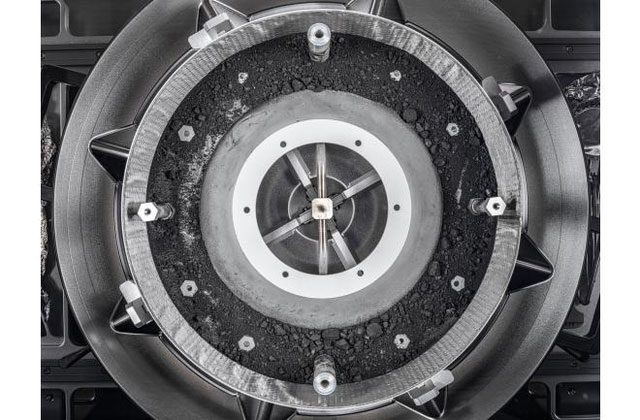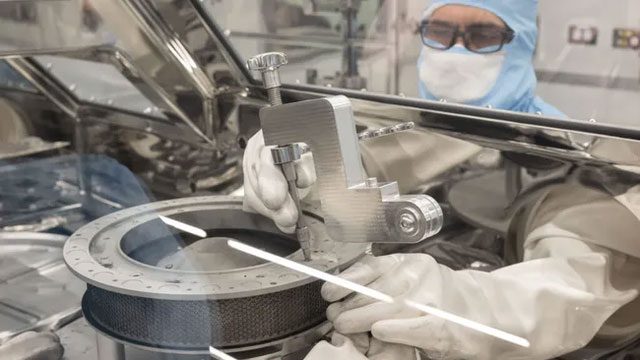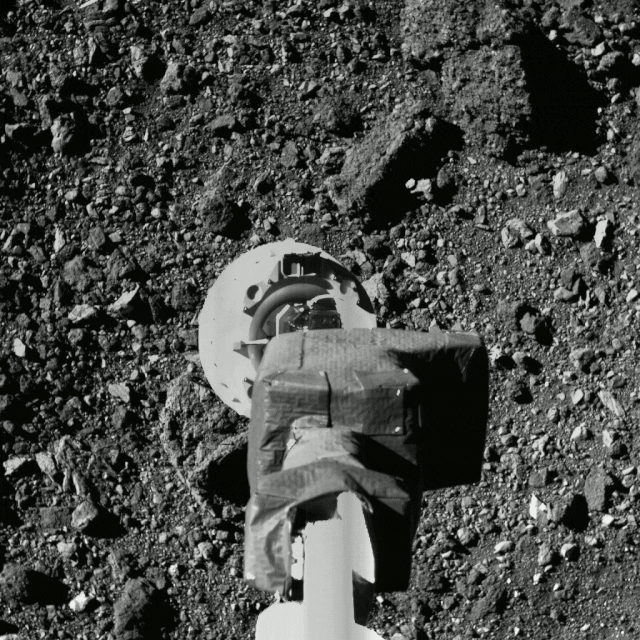After months of effort to find effective methods, scientists from the National Aeronautics and Space Administration (NASA) have finally successfully opened the container holding special materials collected from the asteroid Bennu, which is considered to be “potentially hazardous.” This remarkable event was announced by NASA on January 11.
The retrieved sample, weighing approximately 8.8 ounces (about 250 grams), consists of soil and rock gathered by the OSIRIS-REx spacecraft from the surface of the asteroid Bennu. Highly valued for its scientific significance, this sample is also the first extraterrestrial material collected by a NASA mission.

Approximately 70 grams of rock and soil from Bennu located just outside the sample container.
It is known that NASA scientists recovered the sample container from Bennu on September 24, after it plunged toward Earth from the OSIRIS-REx spacecraft at speeds of up to 27,000 miles per hour (43,000 kilometers per hour). The seven-year journey, covering a distance of 4 billion miles (6.4 billion kilometers), ended safely when the sample container deployed its parachute and landed in the Utah desert before being transported to the Johnson Space Center in Houston, Texas.
However, the sample recovery process faced issues due to two of the 35 locking pins getting stuck, which complicated the opening of the container. Meanwhile, no existing tools were capable of opening these stubborn locks. To ensure no contamination of the sample, NASA had to approve specialized new tools for use in opening the container. Ultimately, a solution was found using two clamp-like tools, resembling surgical clamps, made from stainless steel. These tools were previously tested in the lab to ensure they could safely remove the stubborn locking pins.

The tools used by NASA to open the sample container.
Now that the container has been opened, NASA plans to take “some additional disassembly steps” before proceeding with photographing, extracting, weighing, and processing the remaining sample. Small pieces of rock and soil that were previously collected from the container lid have already been sent worldwide for analysis, and new findings from within the container will soon be explored and studied thoroughly.
Nasa Administrator Bill Nelson, during a press conference regarding the sample’s return, emphasized: “This is the largest sample from a carbon-rich asteroid ever brought back to Earth. Carbon and water molecules are exactly what we want to find. They are crucial factors in forming our planet, and they will help us determine the origins of the elements that may have led to life.”
According to scientists, the water on Earth is believed to be “older” than our planet itself and may have been brought here through collisions with asteroids and comets. However, water is not the only material that asteroids bring to Earth. Materials that helped lay the foundations of life may also have been transported to Earth by a meteorite. Bennu, categorized as a type B asteroid, is known to contain a high amount of carbon and has the potential to hold many primitive molecules that existed when life began on Earth.
For example, the chemical compound uracil—one of the nucleobases of RNA—was recently discovered on the asteroid Ryugu by the Hayabusa2 spacecraft from the Japan Aerospace Exploration Agency, which returned to Earth with its sample in 2020. Scientists from the OSIRIS-REx mission are now hoping to find similar chemical compounds in the Bennu sample.
Nearly “swallowed” by an asteroid far from Earth
Previously, because Bennu is one of the asteroids that could collide with Earth, NASA decided to launch the OSIRIS-REx spacecraft in 2016 with the mission to explore this asteroid, while also bringing back samples for study. It wasn’t until two years later, in 2018, that the spacecraft reached asteroid Bennu.

Stereo image of a rock outcrop on the surface of asteroid Bennu.
When observed through telescopes, astronomers believed that the geological structure of Bennu was quite similar to that of Itokawa, based on information brought back by Japan’s Hayabusa spacecraft in 2010. Accordingly, Bennu was thought to be formed from interspersed boulders and smooth surfaces filled with sand, where the spacecraft could land comfortably.
However, NASA researchers were actually “caught offside.” When OSIRIS-REx took its first close-up look at Bennu, it discovered a “hellish landscape” with sharp rocks jutting high, defying Bennu’s weak gravity. This rendered the initial landing plan, which relied on a laser altimeter for height measurements, completely useless.
To find a suitable landing spot on Bennu, the scientists operating OSIRIS-REx had to use the spacecraft’s camera to meticulously map its surface features down to the centimeter.
Subsequently, with the special assistance of astrophysicist and famous musician Brian May, a 3D stereo image (created by merging two photos to replicate the depth perception of two eyes) was produced. This allowed the OSIRIS-REx operation team to assess the safety of potential landing sites.

The landing of OSIRIS-REx shows that the surface layer of Bennu has a much lower material density compared to the rest of the asteroid.
After 22 months of careful consideration, the researchers decided to choose a site they named Nightingale, where OSIRIS-REx touched down on October 20, 2020. Instead of landing in a 50-meter-diameter landing zone as initially planned, the spacecraft, the size of a truck, had to attempt to settle on a crater only 10 meters wide. Moreover, the operation team had to remotely reprogram the spacecraft to complete the mission.
However, even after selecting the “smoothest” landing site, the probe encountered unexpected issues. First, as soon as it landed on the surface of Bennu, OSIRIS-REx sank about 50 centimeters, as if the spacecraft was being “swallowed” in a bog. Only when the spacecraft fired a quick burst of nitrogen from the TAGSAM propulsion system did OSIRIS-REx’s fate avoid ending on Bennu.
Nevertheless, the force of the jetting bursts was so strong that a large amount of gravel and rocks shot up from the crater and into space. They enveloped the spacecraft as it ascended, threatening its safety. Fortunately, no incidents occurred with OSIRIS-REx.


















































